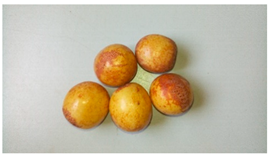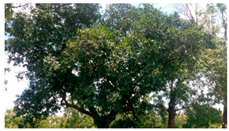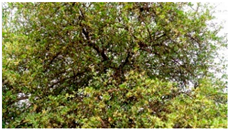Nutritional Characteristics of Four Underutilized Edible Wild Fruits of Dietary Interest in Ghana
Abstract
1. Introduction
2. Materials and Methods
2.1. Source of Raw Materials
2.2. Sample Preparation and Processing
2.3. Chemical Analysis
2.3.1. Proximate
2.3.2. Determination of pH, Total Soluble Solids, and Titratable Acidity
2.3.3. Mineral Determination
2.4. Vitamins (A, B3, C), β-Carotene, Total Polyphenols, and Flavonoids
2.5. Antinutrient Determinations
2.6. Statistical Analysis
3. Results and Discussion
3.1. Proximate and Physicochemical Properties
3.2. Mineral Composition
3.3. Vitamins and Antioxidant Composition
3.4. Antinutrient Composition
4. Conclusions
Author Contributions
Funding
Acknowledgments
Conflicts of Interest
References
- Aworh, O.C. Promoting food security and enhancing Nigeria’s small farmers’ income through value-added processing of lesser-known and under-utilized indigenous fruits and vegetables. Food Res. Int. 2015, 76, 986–991. [Google Scholar] [CrossRef]
- Bvenura, C.; Sivakumar, D. The role of wild fruits and vegetables in delivering a balanced and healthy diet. Food Res. Int. 2017, 99, 15–30. [Google Scholar] [CrossRef] [PubMed]
- Kubola, J.; Siriamornpun, S.; Meeso, N. Phytochemicals, vitamin C and sugar content of Thai wild fruits. Food Chem. 2011, 126, 972–981. [Google Scholar] [CrossRef]
- Alissa, E.M.; Ferns, G.A. Dietary fruits and vegetables and cardiovascular diseases risk. Crit. Rev. Food Sci. Nutr. 2017, 57, 1950–1962. [Google Scholar] [CrossRef] [PubMed]
- Egea, I.; Sánchez-bel, P.; Romojaro, F. Six edible wild fruits as potential antioxidant additives or nutritional supplements. Plant. Foods Hum. Nutr. 2010, 65, 121–129. [Google Scholar] [CrossRef] [PubMed]
- Shaheen, S.; Ahmad, M.; Haroon, N. Nutritional contents and analysis of edible wild plants. In Edible Wild Plants: An Alternative Approach to Food Security; Springer: Basel, Switzerland, 2017; pp. 127–133. [Google Scholar]
- Bach-Faig, A.; Berry, E.M.; Lairon, D.; Reguant, J.; Trichopoulou, A.; Dernini, S.; Medina, F.X.; Battino, M.; Belahsen, R.; Miranda, G.; et al. Mediterranean diet pyramid today. Science and cultural updates. Public Health Nutr. 2011, 14, 2274–2284. [Google Scholar] [CrossRef]
- Burlingame, B.; Charrondiere, U.R.; Dernini, S.; Stadlmayr, B.; Mondovì, S. Food biodiversity and sustainable diets: Implications of applications for food production and processing. In Green Technologies in Food Production and Processing; Boye, J., Arcand, Y., Eds.; Springer: Boston, MA, USA, 2012; pp. 643–657. [Google Scholar]
- Charrondière, U.R.; Stadlmayr, B.; Rittenschober, D.; Mouille, B.; Nilsson, E.; Medhammar, E.; Olango, T.; Eisenwagen, S.; Persijn, D.; Ebanks, K.; et al. Food Chemistry FAO/INFOODS food composition database for biodiversity. Food Chem. 2013, 140, 408–412. [Google Scholar] [CrossRef]
- Dah-nouvlessounon, D.; Adjanohoun, A.; Sina, H.; Noumavo, P.A.; Diarrasouba, N.; Parkouda, C.; Madodé, Y.E.; Dicko, M.H.; Baba-Moussa, L. Nutritional and anti-nutrient composition of three kola nuts (Cola nitida, Cola acuminata and Garcinia kola) produced in Benin. Food Nutr. Sci. 2015, 6, 1395–1407. [Google Scholar] [CrossRef]
- Elinge, C.M.; Muhammad, A.; Atiku, F.A.; Itodo, A.U.; Peni, I.J.; Sanni, O.M.; Mbongo, A.N. Proximate, mineral and anti-nutrient composition of pumpkin (Cucurbita pepo L.) seeds extract. Int. J. Plant. Res. 2012, 2, 146–150. [Google Scholar] [CrossRef]
- Hassan, L.G.; Dangoggo, S.M.; Hassan, S.W.; Muhammad, S.; Umar, K.J. Nutritional and antinutritional composition of Sclerocarya birrea fruit juice. Nigerian J. Basic Appl. Sci. 2010, 18, 222–228. [Google Scholar] [CrossRef]
- Boateng, S.K.; Yeboah, E.A.; Amponsah, J.Y. Wet season collection of edible wild fruits in three Regions of Ghana. J. Plant. Sci. 2007, 2, 353–357. [Google Scholar] [CrossRef]
- Bvenura, C.; Afolayan, A.J. The role of wild vegetables in household food security in South Africa: A review. Food Res. Int. 2015, 76, 1001–1011. [Google Scholar] [CrossRef]
- Ghana Statistical Service (GSS); Ghana Health Service (GHS); ICF International. Ghana Demographic and Health Survey 2014. GSS, GHS, ICF International, 2015. Available online: https://dhsprogram.com/pubs/pdf/fr307/fr307.pdf (accessed on 9 July 2018).
- Ghana Health Service. Ghana: Landscape Analysis of Anemia and Anemia Programming; SPRING: Arlington, VA, USA, 2016; pp. 1–64.
- World Health Organization. Global Prevalence of Vitamin a Deficiency in Populations at Risk 1995–2005: WHO Global Database on Vitamin a Deficiency; WHO Press: Geneva, Switzerland, 2009. [Google Scholar]
- Doku, D.; Koivusilta, L.; Raisamo, S.; Rimpelä, A. Socio-economic differences in adolescents’ breakfast eating, fruit and vegetable consumption and physical activity in Ghana. Public Health Nutr. 2013, 16, 864–872. [Google Scholar] [CrossRef]
- World Health Organization. Diet. Nutrition and the Prevention of Chronic Diseases; World Health Organization: Geneva, Switzerland, 2003; pp. 1–160. [Google Scholar]
- Miller, V.; Yusuf, S.; Chow, C.K.; Dehghan, M.; Corsi, D.J.; Lock, K.; Popkin, B.; Rangarajan, S.; Khatib, R.; Lear, S.A.; et al. Availability, affordability, and consumption of fruits and vegetables in 18 countries across income levels: Findings from the Prospective Urban Rural Epidemiology (PURE) study. Lancet Glob. Health 2016, 4, e695–e703. [Google Scholar] [CrossRef]
- Reicks, M.; Randall, J.L.; Haynes, B.J. Factors affecting consumption of fruits and vegetables by low income families. J. Am. Diet. Assoc. 1994, 94, 1309–1311. [Google Scholar] [CrossRef]
- Valmórbida, J.L.; Vitolo, M.R. Factors associated with low consumption of fruits and vegetables by preschoolers of low socio-economic level. J. Pediatr. 2014, 90, 464–471. [Google Scholar] [CrossRef]
- Woolfe, J.A. The contribution of sweetpotato and its products to human diets. In Sweetpotato Technology for the 21st Century; Hill, W.A., Bonsi, C.K., Loretan, P.A., Eds.; Tuskegee University: Tuskegee, AL, USA, 1992; pp. 367–380. [Google Scholar]
- Nti, C.A.; Hagan, J.; Bagina, F.; Seglah, M. Knowledge of nutrition and health benefits and frequency of consumption of fruits and vegetables among Ghanaian homemakers. Afr. J. Food Sci. 2011, 5, 333–339. [Google Scholar]
- Omari, R.; Quorantsen, K.; Omari, P. Nutrition knowledge and food consumption practices and barriers in rural Ghana: The case of foods for preventing vitamin a and iron deficiencies. Afr. J. Food Agric. Nutr. Dev. 2017, 17, 11639–11656. [Google Scholar] [CrossRef]
- Afari-Sefa, V.; Tenkouano, A.; Ojiewo, C.O.; Keatinge, J.D.H.; Hughes, J.D.A. Vegetable breeding in Africa: Constraints, complexity and contributions toward achieving food and nutritional security. Food Secur. 2012, 4, 115–127. [Google Scholar] [CrossRef]
- Stadlmayr, B.; Charrondière, U.R.; Burlingame, B. Development of a regional food composition table for West Africa. Food Chem. 2013, 140, 443–446. [Google Scholar] [CrossRef]
- Admassu, M.; Bekele, A.; Kim, J.C. Nutritional Composition of Balanites aegyptiaca (Desert Date) and Hyphaene thebaica (Doum Palm) Fruits Consumed by Hamadryas Baboons (Papio hamadryas hamadryas) in Awash National Park, Ethiopia. J. Nutr. Ecol. Food Res. 2013, 1, 198–206. [Google Scholar] [CrossRef]
- Bello, M.O.; Falade, O.S.; Adewusi, S.R.A.; Olawore, N.O. Studies on the chemical compositions and anti nutrients of some lesser known Nigeria fruits. Afr. J. Biotech. 2008, 7, 3972–3979. [Google Scholar]
- Magaia, T.; Uamusse, A.; Sjöholm, I.; Skog, K. Proximate analysis of five wild fruits of mozambique. Sci. World J. 2013, 2013, 1–7. [Google Scholar] [CrossRef]
- Magaia, T. Chemical Analysis to promote the use of wild fruits from Mozambique Lund University. Ph.D. Thesis, Lund University, Lund, Sweden, September 2015. [Google Scholar]
- Zang, C.U.; Jock, A.A.; Garba, I.H.; Chindo, I.Y. Physicochemical and Phytochemical Characterization of Seed Kernel oil From Desert Date (Balanites Aegyptiaca). J. Chem. Eng.Bioanal. Chem. 2017, 2, 49–61. [Google Scholar] [CrossRef]
- Afolabi, I.S. Moisture Migration and Bulk Nutrients Interaction in a Drying Food Systems: A Review. Food Nutr. Sci. 2014, 5, 692–714. [Google Scholar] [CrossRef]
- AOAC. Official Methods of Analysis of AOAC International, 19th ed.; AOAC International: Gaithersburg, MD, USA, 2012. [Google Scholar]
- Singleton, V.L.; Orthofer, R.; Lamuela-Raventos, R.M. Analysis of total phenols and other oxydant substrates and antioxydants by means of Folin-ciocalteu reagent. Methods Enzymol. 1999, 299, 152–178. [Google Scholar]
- Meda, A.; Laien, C.E.; Romito, M.; Millogo, J.; Nacoulma, O.G. Determination of total phenolic, flavonoid and proline contents in Burkina Faso honeys as well as well as their radical scavenging activity. Food Chem. 2005, 91, 571–577. [Google Scholar] [CrossRef]
- Latta, M.; Eskin, M. A simple and rapid colorimetric method for phytate determination. J. Agric. Food Chem. 1980, 28, 1313–1315. [Google Scholar] [CrossRef]
- Day, R.; Underwood, A. Quantitative Analysis, 5th ed.; Prentice-Hall Publication: Upper Saddle River, NJ, USA, 1986. [Google Scholar]
- Price, M.L.; Van Scoyoc, S.; Butler, L.G. A critical evaluation of the vanillin reaction as an assay for tannin in sorghum grain. J. Agric. Food Chem. 1978, 26, 1214–1218. [Google Scholar] [CrossRef]
- Obadoni, B.O.; Ochuko, P.O. Phytochemical studies and comparative efficacy of the crude extracts of some homeostatic plants in Edo and Delta States of Nigeria. Glob. J. Pure Appl. Sci. 2001, 86, 203–208. [Google Scholar]
- Amarteifio, J.O.; Mosase, M.O. The Chemical Composition of Selected Indigenous Fruits of Botswana. J. Appl. Sci. Environ. Manage. 2006, 10, 43–47. [Google Scholar] [CrossRef]
- Murray, S.; Schoeninger, M.J.; Bunn, H.T.; Pickering, T.R.; Marlett, J.A. Nutritional composition of some wild plant foods and honey used by Hadza foragers of Tanzania. J. Food Compos. Anal. 2001, 14, 3–13. [Google Scholar] [CrossRef]
- Otten, J.J.; Hellwig, J.P.; Meyers, L.D. Dietary Reference Intakes: The Essential Guide to Nutrient Requirements; Institute of Medicine: Washington, DC, USA, 2006. [Google Scholar]
- Mateke, S.M. Botswana’s Indigenous Fruit Tree Domestication and Improvement Project 1997–2001, Final Report. 2001. [Google Scholar]
- Theobald, H.E. Dietary calcium and health. Nutr. Bulletin. 2005, 30, 237–277. [Google Scholar] [CrossRef]
- Palmer, B.F. Regulation of potassium homeostasis. Clin. J. Am. Soc. Nephrol. 2015, 10, 1050–1060. [Google Scholar] [CrossRef]
- Ringer, J.; Bartlett, Y. The significance of potassium. Pharm. J. 2007, 278, 497–500. [Google Scholar]
- Appel, L.J. Nonpharmacologic therapies that reduce blood pressure: A fresh perspective. Clin. Cardiol. 1999, 22, 1111–1115. [Google Scholar] [CrossRef]
- Jasar, D.; Kubelka-sabit, K.; Trajkovska, B.C.; Filipovski, V. Vitamin B3 dietary intake and its role in aging. J. Hyg. Eng. Des. 2015, 13, 90–93. [Google Scholar]
- Pullar, J.M.; Carr, C.; Vissers, M.C. The roles of vitamin C in skin health. Nutrients. 2017, 9, 866. [Google Scholar] [CrossRef]
- Dave, K.N.; Patil, R.S. Biological importance of ascorbic acid (vitamin C) in human health—A classic review. Int. J. Res. Biol. Pharm. 2017, 3, 1–8. [Google Scholar]
- Aslam, M.F.; Majeed, S.; Aslam, S.; Irfan, J.A. Vitamins: Key role players in boosting up immune response—A mini review. Vitam. Miner. 2017, 6, 153. [Google Scholar] [CrossRef]
- Fiedor, J.; Burda, K. Potential role of carotenoids as antioxidants in human health and disease. Nutrients 2014, 6, 466–488. [Google Scholar] [CrossRef]
- Ozcan, T.; Akpinar-Bayizit, A.; Yilmaz-Ersan, L.; Delikanli, B. Phenolics in human health. Int. J. Chem. Eng. Appl. 2014, 5, 393–396. [Google Scholar] [CrossRef]
- Tiwari, S.C.; Husain, N. Biological activities and role of flavonoids in human health—A review. Indian J. Sci. Res. 2017, 12, 193–196. [Google Scholar]
- Thompson, L.U. Potential health benefits and problems associated with antinutrients in foods. Food Res. Int. 1993, 26, 131–149. [Google Scholar] [CrossRef]
- Nititham, S.; Komindr, S.; Nichachotsalid, A. Phytate and fiber content in Thailand fruits commonly consumed by diabetic patients. J. Med. Assoc. Thai. 2004, 87, 1444–1446. [Google Scholar]
- Muhammed, I.; Muh, S.; Olorunju, S.; Bale, J.; Abdullahi, U.; Lawal, R. Response of nutrients and anti-nutritional constituents in the seeds of Cassia tora L. to treatments. J. Agric. Environ. 2002, 3, 225–234. [Google Scholar]
- Faizal, A.; Geelen, D. Saponins and their role in biological processes in plants. Phytochem. Rev. 2013, 12, 877–893. [Google Scholar] [CrossRef]
- Bora, P. Anti-nutritional factors in foods and their effects. J. Academ. Indust Res. 2014, 3, 285–290. [Google Scholar]
- Garcia-Casal, M.N. Carotenoids increase iron absorption from cereal-based food in the human. Nutr. Res. 2006, 26, 340–344. [Google Scholar] [CrossRef]
| English Name | Scientific Name/Plant | Picture (Fruit) | Sampling Date |
|---|---|---|---|
| Unknown | Gardenia erubescens |  | 18 March 2018 |
 | |||
| Marula | Sclerocarya birrea |  | 18 March 2018 |
 | |||
| African ebony | Diospyros mespiliformis |  | 19 March 2018 |
 | |||
| Desert date | Balanites aegyptiaca |  | 19 March 2018 |
 |
| Property | Fruit Samples | |||
|---|---|---|---|---|
| G. erubescens | S. birrea | D. mespiliformis | B. aegyptiaca | |
| Moisture (%) * | 70.43 ± 0.24 a | 85.84 ± 0.14 b | 6.01 ± 0.00 # | 18.27 ± 0.10 c |
| Dry matter (%) * | 29.57 ± 0.21 a | 14.16 ± 0.38 b | 93.99 ± 0.02 # | 81.73 ± 0.92 c |
| Carbohydrate (%) | 76.44 ± 0.51 a | 61.69 ± 0.69 b | 75.23 ± 0.40 a | 73.63 ± 0.38 c |
| Protein (%) | 8.83 ± 0.09 a | 12.48 ± 0.02 b | 10.26 ± 0.01 c | 9.19 ± 0.05 d |
| Ash (%) | 3.4 ± 0.20 a | 6.37 ± 0.25 b | 3.00 ± 0.20 a | 4.4 ± 0.20 c |
| Fat (%) | 4.53 ± 0.22 a | 9.68 ± 0.17 b | 3.51 ± 0.18 c | 2.58 ± 0.37 d |
| Fiber (%) | 2.27 ± 0.14 a | 4.25 ± 0.17 b | 2.00 ± 0.13 a | 2.93 ± 0.14 c |
| Energy (kcal) | 381.85 ± 1.61 a | 383.81 ± 2.24 a | 373.55 ± 1.00 b | 354.48 ± 1.93 c |
| pH | 4.64 ± 0.05 a | 4.20 ± 0.02 b | 5.44 ± 0.04 c | 5.35 ± 0.03 c |
| TSS (°Brix) | 1.01 ± 0.43 a | 1.21 ± 0.33 a | 1.56 ± 0.15 a | 1.27 ± 0.61 a |
| TA (% citric acid) | 1.04 ± 0.07 a | 1.98 ± 0.31 b | 2.04 ± 0.03 b | 2.35 ± 0.47 b |
| Mineral | Fruit Samples | |||
|---|---|---|---|---|
| G. erubescens | S. birrea | D. mespiliformis | B. aegyptiaca | |
| Calcium | 6.48 ± 0.04 a | 14.95 ± 0.17 b | 8.81 ± 0.28 c | 10.58 ± 0.11 d |
| Potassium | 133.41 ± 2.37 a | 133.02 ± 2.23 a | 129.4 ± 1.62 a | 131.60 ± 2.69 a |
| Phosphorus | 46.37 ± 0.91 a | 103.87 ± 4.32 b | 64.78 ± 2.98 c | 55.23 ± 0.23 d |
| Magnesium | 168.07 ± 0.44 a | 177.69 ± 0.43 b | 162.98 ± 0.42 c | 166.81 ± 0.51 d |
| Sodium | 2.64 ± 0.04 a | 1.75 ± 0.04 b | 1.25 ± 0.03 c | 1.43 ± 0.05 d |
| Iron | 0.48 ± 0.08 a | 0.43 ± 0.02 ab | 1.46 ± 0.03 c | 0.34 ± 0.01 b |
| Zinc | 0.81 ± 0.02 a | 2.97 ± 0.03 b | 1.70 ± 0.03 c | 2.02 ± 0.03 d |
| Nutrient | Fruit Samples | |||
|---|---|---|---|---|
| G. erubescens | S. birrea | D. mespiliformis | B. aegyptiaca | |
| Vitamin B3 | 146.30 ± 1.48 a | 932.74 ± 7.24 b | 310.22 ± 8.15 c | 227.85 ± 3.80 d |
| Vitamin C | 73.08 ± 2.23 a | 172.49 ± 6.01 b | 44.67 ± 3.06 c | 105.97 ± 2.57 d |
| Vitamin A | 1.17 ± 0.24 a | 2.03 ± 0.03 b | 1.57 ± 0.32 ab | 0.84 ± 0.03 ac |
| β-carotene | 111.01 ± 0.43 a | 176.89 ± 9.89 b | 89.16 ± 0.77 c | 64.84 ± 2.47 d |
| Polyphenol (GAE) | 82.28 ± 8.33 a | 111.06 ± 0.10 b | 53.39 ± 1.70 c | 110.44 ± 1.11 b |
| Flavonoid (QE) | 172.67 ± 8.08 a | 237.67 ± 13.50 b | 94.00 ± 4.00 c | 160.00 ± 6.00 a |
| Fruit | Antinutrient | |||
|---|---|---|---|---|
| Phytate | Oxalate | Tannin | Saponin | |
| Gardenia erubescens | 0.06 ± 0.02 a | 0.25 ± 0.02 a | 0.29 ± 0.09 a | 0.72 ± 0.08 a |
| Sclerocarya birrea | 0.64 ± 0.04 b | 0.11 ± 0.00 b | 0.59 ± 0.08 b | 1.05 ± 0.06 b |
| Diospyros mespiliformis | 0.27 ± 0.02 c | 0.14 ± 0.00 c | 0.46 ± 0.13 ab | 0.22 ± 0.01 c |
| Balanites aegyptiaca | 1.82 ± 0.09 d | 0.38 ± 0.00 d | 0.40 ± 0.03 ab | 0.62 ± 0.06 a |
© 2019 by the authors. Licensee MDPI, Basel, Switzerland. This article is an open access article distributed under the terms and conditions of the Creative Commons Attribution (CC BY) license (http://creativecommons.org/licenses/by/4.0/).
Share and Cite
Achaglinkame, M.A.; Aderibigbe, R.O.; Hensel, O.; Sturm, B.; Korese, J.K. Nutritional Characteristics of Four Underutilized Edible Wild Fruits of Dietary Interest in Ghana. Foods 2019, 8, 104. https://doi.org/10.3390/foods8030104
Achaglinkame MA, Aderibigbe RO, Hensel O, Sturm B, Korese JK. Nutritional Characteristics of Four Underutilized Edible Wild Fruits of Dietary Interest in Ghana. Foods. 2019; 8(3):104. https://doi.org/10.3390/foods8030104
Chicago/Turabian StyleAchaglinkame, Matthew Atongbiik, Ruth Olaide Aderibigbe, Oliver Hensel, Barbara Sturm, and Joseph Kudadam Korese. 2019. "Nutritional Characteristics of Four Underutilized Edible Wild Fruits of Dietary Interest in Ghana" Foods 8, no. 3: 104. https://doi.org/10.3390/foods8030104
APA StyleAchaglinkame, M. A., Aderibigbe, R. O., Hensel, O., Sturm, B., & Korese, J. K. (2019). Nutritional Characteristics of Four Underutilized Edible Wild Fruits of Dietary Interest in Ghana. Foods, 8(3), 104. https://doi.org/10.3390/foods8030104





